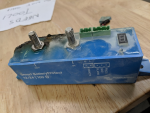dreadlocks
Well-known member
for inspiration here's my diagram

Diagrams I look at depict a fuse between PV and SC, unless your PV array is big, then a breaker. wire gauge off the PV is prob 10g, and your SC choice has screw terms accepting 8g in and out. If you have more than one PV, you'll want a combiner box, then into SC. I'm reading a BP for charge circuit prior to battery. a 'thick'(2/0 ?) cable off battery negative to shunt, then all negatives branch from there...partial thoughts...i'm consumer level, consuming ideas...i've seen 3/8ths inch pos and neg freestanding terminal posts so that only one attachment to your pos battery terminal.

I just crimped on some power poles to a little pigtail plugged right into SmartSolar.. if I need to disconnect them for work I can just unplug em, no sparks or risk of shorting.. and simple.. I put a locking pin in em so I dont even consider it a point of failure..
These are not huge loads were talking about, nothing the powerpole cant handle.. if you wanted to cut power suddenly pulling it off the high voltage side would be the safest way to do it.. wont cause a potential voltage spike.. some people put switches, those connect w/load safely.. dun see how this is much different.
If you were to say run a solid wire from a fixed panel to your controller, whats going to happen if your controller needs replaced or you need to work on an de-energized electrical system? you'll have some hot wires dangling from solar that need to be reattached half an inch apart w/no stray touching.. that would be bad.. what if you need to manually reboot the solar controller out in BFE, you pulling out a screw driver and yanking out wires? or just unplug the solar panel? Put plugs or some way to disconnect solar if your doing a fixed+hardwired setup or you'll regret it.
First off @dreadlocks an excellent drawing!! My question concerns the post about using the Smart Protect backwards. Are you not using it backwards since you have charge sources and load devices connected to same side of Smart Protect? I haven't studied the Smart Protect yet so it is kind of confusing.for inspiration here's my diagram

Great video. One thing I noted is the alternator often has a smaller pully so engine RPM does not = alternator RPM.
Maybe fuses/disconnecs aren't shown if not some could be added....and a chassis ground for the buss bar.Well I spent 3hrs at Northern Arizona Wind and Sun yesterday between picking up my 360w LG panel, misc bits and figuring out how to wire all this Victron love together.
I am working on a new draw.io diagram as there are power, ground and communication leads running around.
View attachment 541424
Maybe fuses/disconnecs aren't shown if not some could be added....and a chassis ground for the buss bar.
